
Original Link: https://www.anandtech.com/show/1072
Intel Developer Forum Spring 2003 - Day 2: Learn about Prescott & Centrino
by Anand Lal Shimpi on February 19, 2003 1:06 PM EST- Posted in
- Trade Shows
There's a lot to talk about on the second day of IDF; we just finished the keynote and there's a wealth of information to report so let's get to it...
Anand Chandrasekher talks about Centrino
With Intel's Centrino mobile technology due to be launched on March 12, it's no surprise that the first topic of discussion for today's keynote was Centrino and the Pentium M processor.
To clear up the confusion, the Centrino brand name can only be used in mobile solutions where the following components are in place - Intel Pentium M processor (formerly known as Banias), Intel 855 chipset and Intel Pro/Wireless 2100 networking hardware. So when we talk about Centrino, we're actually talking about a mobile technology and not an individual CPU.
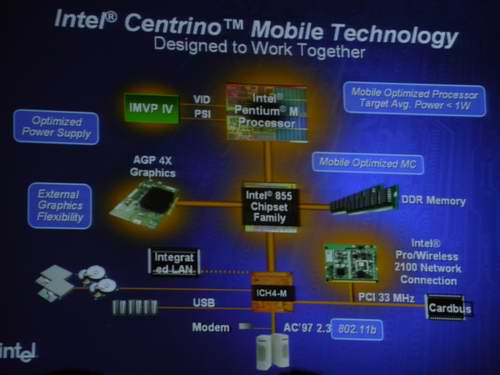
Intel's strategy with Centrino is to offer an incredible amount of marketing dollars to aid their partners that choose to implement the Centrino mobile technology over the next two years (on the order of $2 billion). By doing this, Intel effectively pushes all competing chipset manufacturers out of the mobile business (remember, you need to use the 855 chipset if you want to call your notebook a Centrino), since no manufacturers would even dream of turning down Intel's marketing dollars. Looking at Intel's desktop chipset strategy, it's clear that Intel is intent on being the single chipset provider for as much of the PC industry as possible by using their marketing muscle to their benefit. Thankfully Intel currently makes the most reliable, high performing chipsets around, so there's nothing to complain about here.
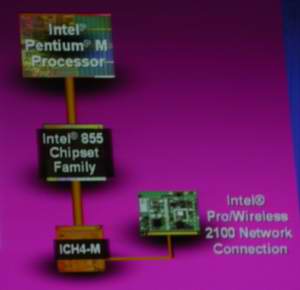
As we've mentioned before, the Pentium M (Banias) borrows a significant architecture base from the Pentium III core but with a handful of power enhancements. Performance enhancements include a 1MB L2 cache, the largest for any desktop/mobile 0.13-micron CPU as well as a 400MHz NetBurst FSB identical to the one used in the first Pentium 4s. In order to save power you won't see 533MHz FSB support, nor will you see anything other than DDR266 memory used on Centrino platforms.

Intel talked a bit about the performance of the Centrino platform by comparing the following platforms: a 1.2GHz mobile Pentium III, 2.4GHz Pentium 4-M and a 1.6GHz Pentium M Centrino system.
Intel ran a series of unspecified tests on the three platforms simultaneously, all Intel informed us of was the fact that they were doing everything from Spreadsheet tasks to DVD creation tasks. It sounds to us like they did a lot of multitasking involving video encoding as well as some basic office tasks, and obviously the test was designed to show off the performance of the Pentium M processor as best as possible.
The outcome of the test was quite positive, here are Intel's official results:
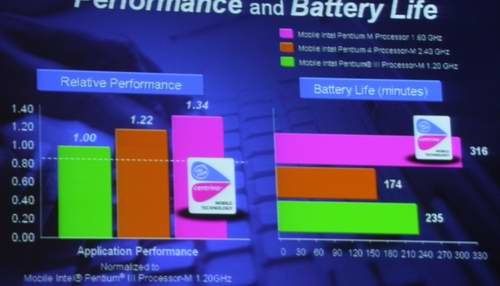
The green bar is the mobile Pentium III, the orange bar is the Pentium 4-M and the pink bar is the Pentium M. As you can see, the performance of the solution is quite strong, and it effectively pushes the Pentium 4-M out of the majority of the notebook market. We still expect the Pentium 4 to remain in the absolute highest performance desktop replacement systems, but Centrino and Pentium M will occupy the majority of the other mobile segments in existence.
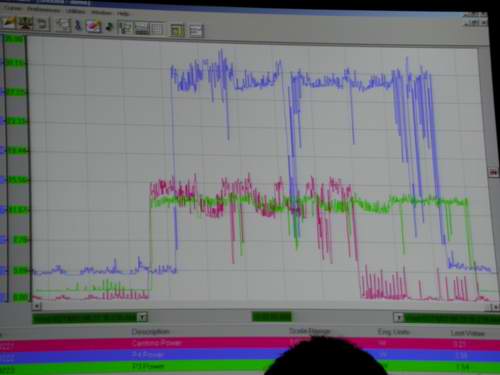
Intel also monitored power consumption of the three processors during the test, the results of which you can see above. The pink line represents the Pentium M, the blue and green represent the Pentium 4-M and mobile Pentium III respectively. The things to take away from this chart is that in its idle state, the 1.6GHz Pentium M consumes less power than the mobile Pentium III. The mobile Pentium III vs. Pentium M comparison is an important one to make because the two processors use very similar microarchitectures, so the higher clocked Pentium M using less power gives you an indication of exactly how beneficial the architecture enhancements to the Pentium M core are.
Under peak usage, the Pentium M does have slightly higher power consumption than the mobile Pentium III, but you'll also notice that there are points during which the Pentium M's power consumption drops a significant amount - these are points where the Pentium M's power saving technologies are kicking into effect and powering down parts of the chip or FSB that are idle, thus causing a decrease in power consumption.
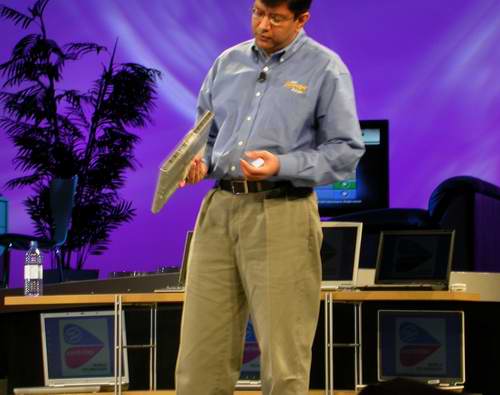
Anand shows off a Tablet PC using Centrino mobile technology
Anand Chandrasekher finished up his portion of the keynote by showing off solutions from most of the major vendors, including two proud Taiwanese makers - ASUS and FIC.

Anand holding a 300mm Pentium M wafer
Anand did make a brief mention about the future of the Pentium M processor with a few words about the 90nm successor to Banias codenamed Dothan. Although much hasn't been disclosed about Dothan, we can say that it will have a massive 2MB L2 cache which is simply incredible when it comes to a mobile CPU. Dothan is due out at the beginning of 2004 and is pin compatible with the current Pentium M processor and will work in all current Centrino platforms.
Anand Chandrasekher on Newport
Yesterday we introduced you to the Newport concept mobile PC, today Anand Chandrasekher took another look at the platform:
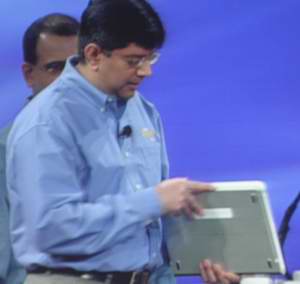
There wasn't much more to talk about Newport, although Anand did mention that the battery life in notebook mode of the Newport concept would be approximately 6 hours courtesy of additional batteries (probably a second battery) or 2.5 hours when in tablet mode (probably only a single, lightweight battery in use).
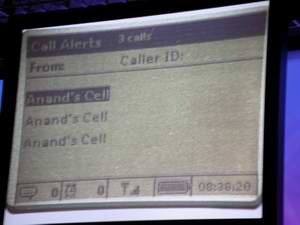
There was another demo of the closed-lid computing functionality of the Newport concept, this time where it was used to handle incoming cellphone calls; not exactly the best demonstration of the functionality, but it was neat to see nonetheless.
Before finishing up his time on the stage, Anand Chandrasekher briefly spoke to new power saving technologies:
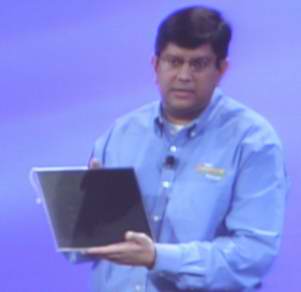
The first technology he mentioned was the LCD panel used in the Newport concept, whose power consumption was approximately 3 watts.

Next we have the first fuel cell used in powering a notebook, in this case the fuel cell is capable of delivering 150 W/hrs of power. This is compared to the 40 - 50 W/hrs of conventional batteries, in something that is only slightly larger. The technology is still a while away, but the possibilities are definitely promising.
Intel Inside your Cellphone
Before we move on to the interesting desktop announcements, we want to touch on Intel's PXA800F chip that was just recently announced for use in cellular telephones.
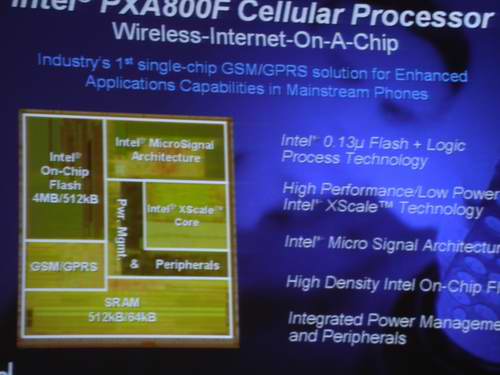
The beauty of the PXA800F is that it integrated a very powerful XScale microprocessor core with a non-trivial amount of flash memory and cache that not only help performance, but also reduce power consumption significantly.
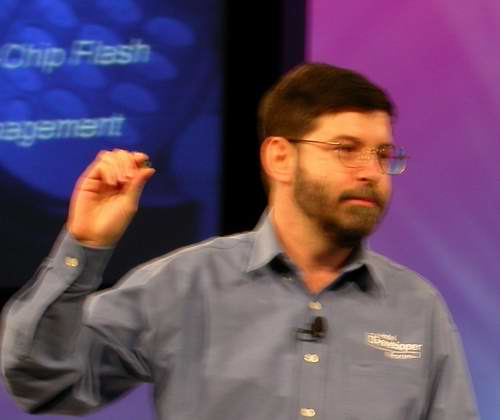
To give you an idea of how small this single chip cellular solution is, have a look at the picture above - can you see it? The PXA800F will enable even smaller cellphone designs, especially because of the fact that it is so highly integrated.
Prescott gets 13 new Instructions
What everyone was expecting Louis Burns to talk about was Intel's forthcoming 90nm Pentium 4, codenamed Prescott:

We already knew about the 1MB L2 cache and the 800MHz FSB, but the 13 new instructions was news to us. We're about to find out exactly what those 13 new instructions are, so we'll report on those later today. Another point not mentioned here is that Prescott will have a 16KB L1 data cache, up from the 8KB L1 data cache in the current Northwood processors. The increase in L1 and L2 cache sizes will improve Hyper-Threading performance, although it's not clear as to whether HT performance will improve as a result of other optimizations to the technology in Prescott.

Intel's Louis Burns proudly displaying a massive 300mm Prescott wafer
Louis went on to talk about the 865 and 875 chipsets, including live demonstrations of both of them (Springdale & Canterwood):

Intel's 875 (Canterwood) chipset running Windows Media Center Edition
Louis spoke about the 875 chipset's Performance Acceleration Technology (PAT) or "Turbo mode" as we've come to know it. He confirmed our original theories that it optimizes the memory controller for DDR400 operation, and the technology will only be built into the 875MCH - most likely in the form of deeper buffers optimized for dual channel DDR400 memory transfers.

With Louis' 865 (Springdale) slide we were able to see on paper what we've been talking about since Comdex. Here you'll see the Communications Streaming Architecture (CSA) stemming off from the 865 MCH in order to provide dedicated bandwidth to Intel Gigabit Ethernet solutions as we've mentioned in the past. For more information on Intel's 865 and 875 chipsets be sure to take a look at our coverage posted to the newsletter last night.
Before closing, Louis Burns spoke about Intel's vision for PCs in 2004 with their Powersville desktop concept:
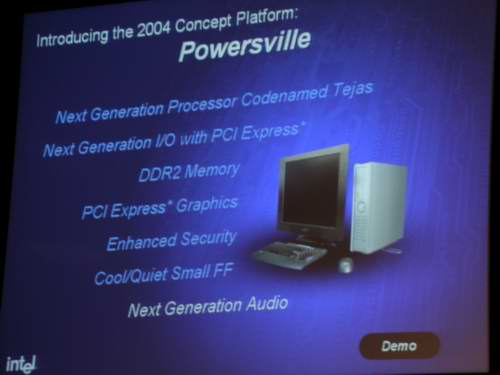
Here we see the first public mention of Intel's Tejas processor, the replacement for Prescott. As we mentioned years ago, Tejas will use at least a 1.2GHz FSB but we aren't familiar with the rest of the processor's specifications at this point.
We mentioned yesterday that Intel is expecting PCI Express to be on all systems by 2004, and their Powersville concept supports this idea. Note that Intel will be transitioning to DDR2 in 2004, with no mention of using RDRAM anytime soon; and take note of the move to PCI Express Graphics as well.
Intel also announced their Azalia next-generation audio specification, designed as a replacement to the current AC'97 specification. Details are sketchy at best at this point, but Intel wants to enable technologies such as DVD-Audio and SACD playback, as well as multiple audio output streams through the Azalia specification. Intel will be publishing the specification later this year with availability of products planned for late 2004.
Final Words
It's off to find out what Prescott's 13 new instructions are right now, we'll be back shortly...







